tire pressure TOYOTA CAMRY 2011 XV50 / 9.G Owners Manual
[x] Cancel search | Manufacturer: TOYOTA, Model Year: 2011, Model line: CAMRY, Model: TOYOTA CAMRY 2011 XV50 / 9.GPages: 554, PDF Size: 9.69 MB
Page 5 of 554

1
2
3
4
5
6
7
5
4-3. Do-it-yourself maintenance
Do-it-yourself service precautions ....................... 365
Hood ................................... 368
Positioning a floor jack ........ 369
Engine compartment ........... 371
Tires .................................... 387
Tire inflation pressure ......... 397
Wheels ................................ 401
Air conditioning filter............ 403
Key battery .......................... 406
Checking and replacing fuses ................................. 410
Light bulbs........................... 423
5-1. Essential information Emergency flashers ............ 428
If your vehicle needs to be towed ........................... 429
If you think something is wrong ............................ 432
Fuel pump shut off system .............................. 433
Event data recorder ............ 434 5-2. Steps to take in an
emergency
If a warning light turns on or a warning buzzer
sounds... .......................... 436
If a warning message is displayed .......................... 448
If you have a flat tire ........... 458
If the engine will not start.... 469
If the shift lever cannot be shifted from P .............. 471
If you lose your keys........... 472
If the electronic key does not operate properly ......... 473
If the battery is discharged........................ 475
If your vehicle overheats .... 479
If the vehicle becomes stuck ................................. 482
If your vehicle has to be stopped in an
emergency ....................... 484
5When trouble arises
Page 9 of 554
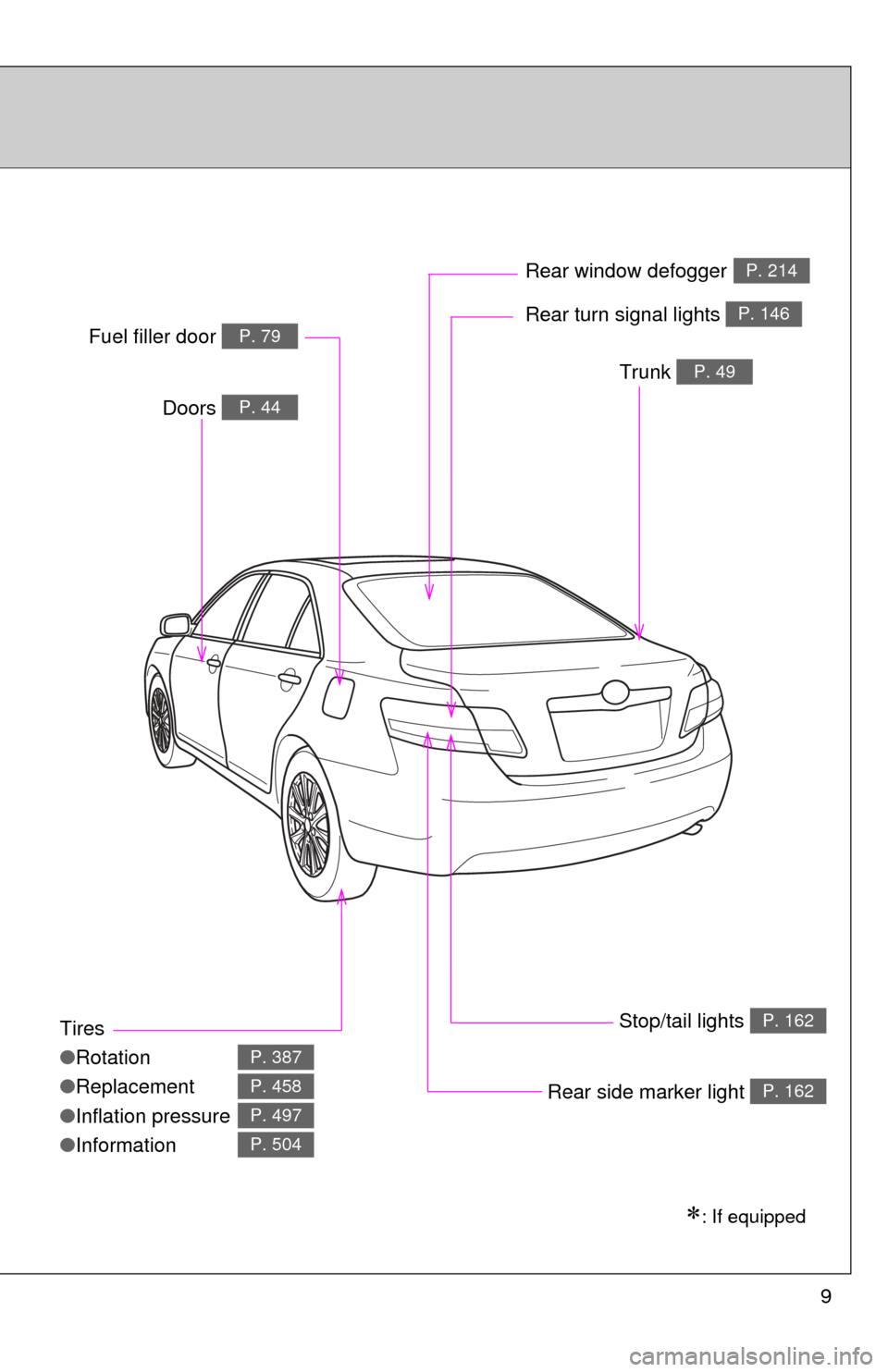
9
Tires
●Rotation
● Replacement
● Inflation pressure
● Information
P. 387
P. 458
P. 497
P. 504
Trunk P. 49
Doors P. 44
Fuel filler door P. 79Rear turn signal lights P. 146
Rear window defoggerP. 214
Stop/tail lights P. 162
: If equipped
Rear side marker light P. 162
Page 15 of 554
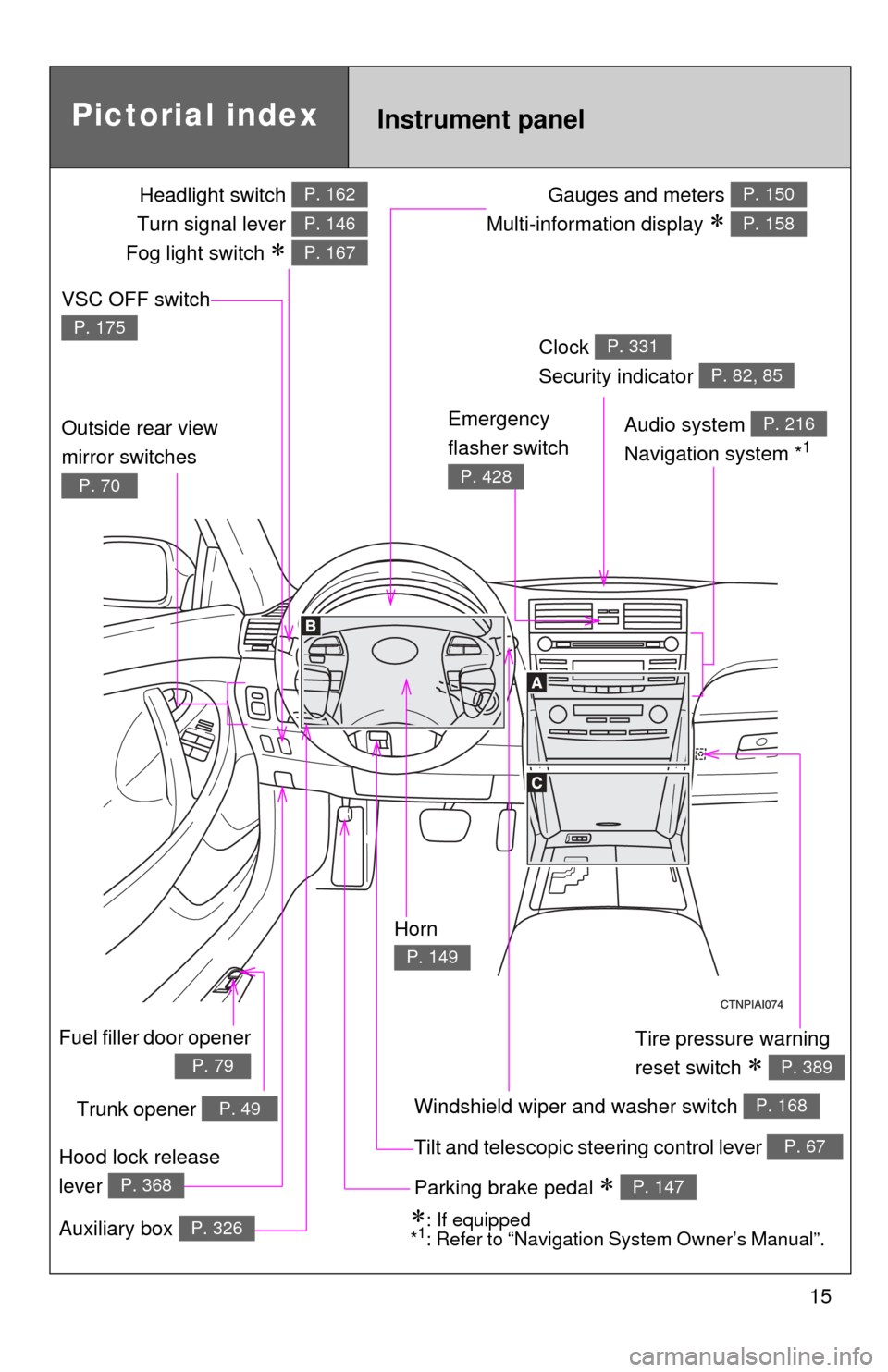
15
Gauges and meters
Multi-information display
P. 150
P. 158
Tilt and telescopic steering control lever P. 67
Pictorial index
Trunk opener P. 49
Headlight switch
Turn signal lever
Fog light switch
P. 162
P. 146
P. 167
Instrument panel
Audio system
Navigation system *1
P. 216
Windshield wiper and washer switch P. 168
Clock
Security indicator P. 331
P. 82, 85
Outside rear view
mirror switches
P. 70
Tire pressure warning
reset switch
P. 389
Parking brake pedal P. 147
Hood lock release
lever
P. 368
Fuel filler door opener
P. 79
Auxiliary box P. 326: If equipped
*1: Refer to “Navigation System Owner’s Manual”.
Emergency
flasher switch
P. 428
VSC OFF switch
P. 175
Horn
P. 149
Page 178 of 554

178 2-4. Using other driving systems
CAUTION
■When VSC is activated
The slip indicator light flashes. Always drive carefully. Reckless driving may
cause an accident. Exercise particular care when the indicator light flashes.
■ When TRAC and VSC are off
Be especially careful and drive at a speed appropriate to the road condi-
tions. As these are systems to ensure vehicle stability and driving force, do
not turn off TRAC and VSC unless necessary.
■ Replacing tires
Make sure that all tires are of the same size, brand, tread pattern and total
load capacity. In addition, make sure that the tires are inflated to the recom-
mended tire pressure level.
The ABS and VSC system will not function correctly if different tires are fitted
on the vehicle.
Contact your Toyota dealer for further information when replacing tires or
wheels.
■ Handling of tires and suspension
Using tires with any kind of problem or modifying the suspension will affect
the driving assist systems, and may cause the system to malfunction.
Page 185 of 554
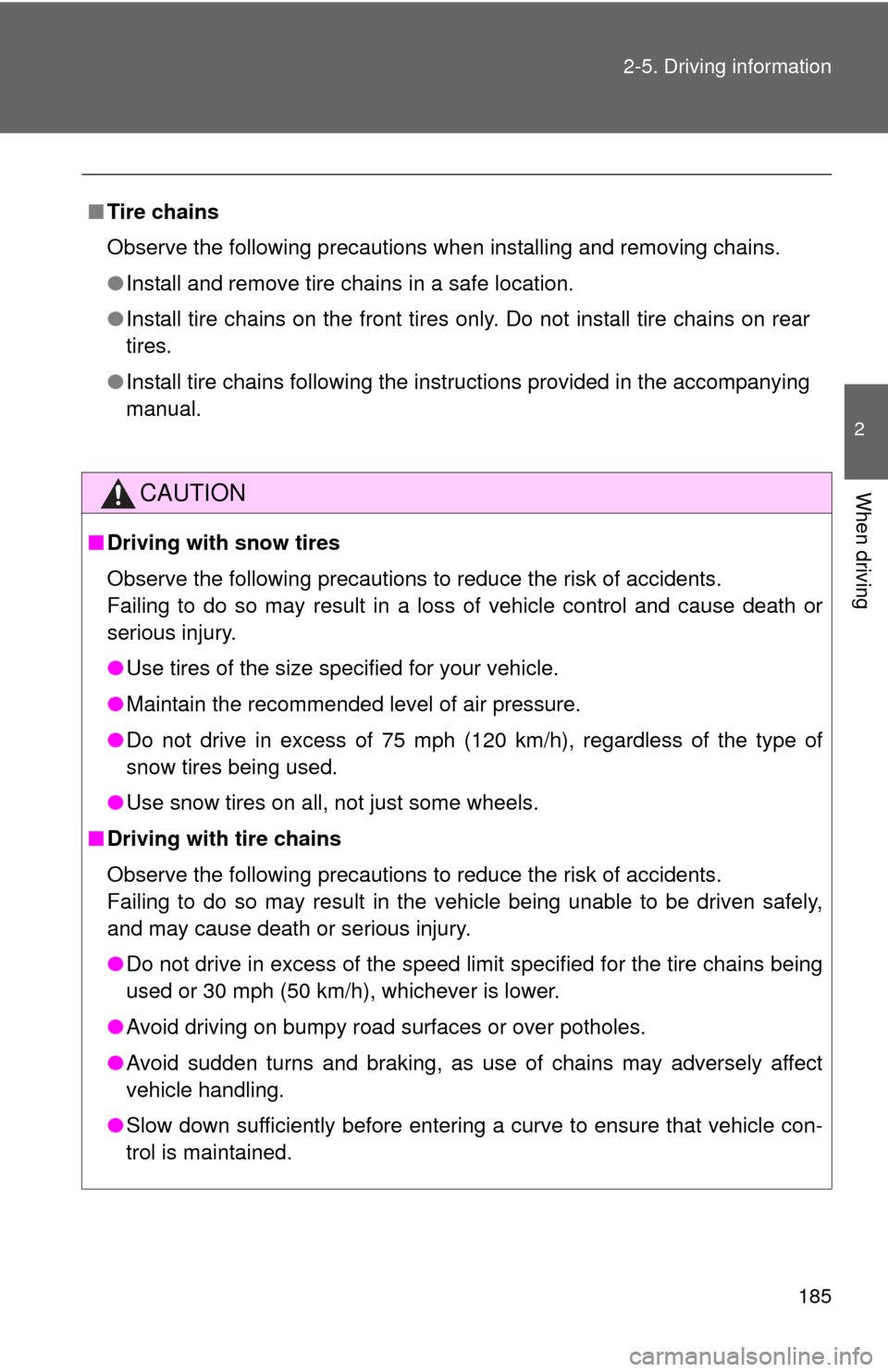
185
2-5. Driving information
2
When driving
■
Tire chains
Observe the following precautions when installing and removing chains.
●Install and remove tire chains in a safe location.
● Install tire chains on the front tires only. Do not install tire chains on rear
tires.
● Install tire chains following the instructions provided in the accompanying
manual.
CAUTION
■Driving with snow tires
Observe the following precautions to reduce the risk of accidents.
Failing to do so may result in a loss of vehicle control and cause death or
serious injury.
●Use tires of the size specified for your vehicle.
● Maintain the recommended level of air pressure.
● Do not drive in excess of 75 mph (120 km/h), regardless of the type of
snow tires being used.
● Use snow tires on all, not just some wheels.
■ Driving with tire chains
Observe the following precautions to reduce the risk of accidents.
Failing to do so may result in the vehicle being unable to be driven safely,
and may cause death or serious injury.
●Do not drive in excess of the speed limit specified for the tire chains being
used or 30 mph (50 km/h), whichever is lower.
● Avoid driving on bumpy road surfaces or over potholes.
● Avoid sudden turns and braking, as use of chains may adversely affect
vehicle handling.
● Slow down sufficiently before entering a curve to ensure that vehicle con-
trol is maintained.
Page 186 of 554

186 2-5. Driving information
NOTICE
■Repairing or replacing snow tires
Request repairs of and obtain replacement snow tires from Toyota dealers or
legitimate tire retailers.
This is because the removal and attachment of snow tires affects the opera-
tion of the tire pressure warning valves and transmitters.
■ Fitting tire chains
The tire pressure warning valves and transmitters may not function correctly\
when tire chains are fitted.
Page 353 of 554
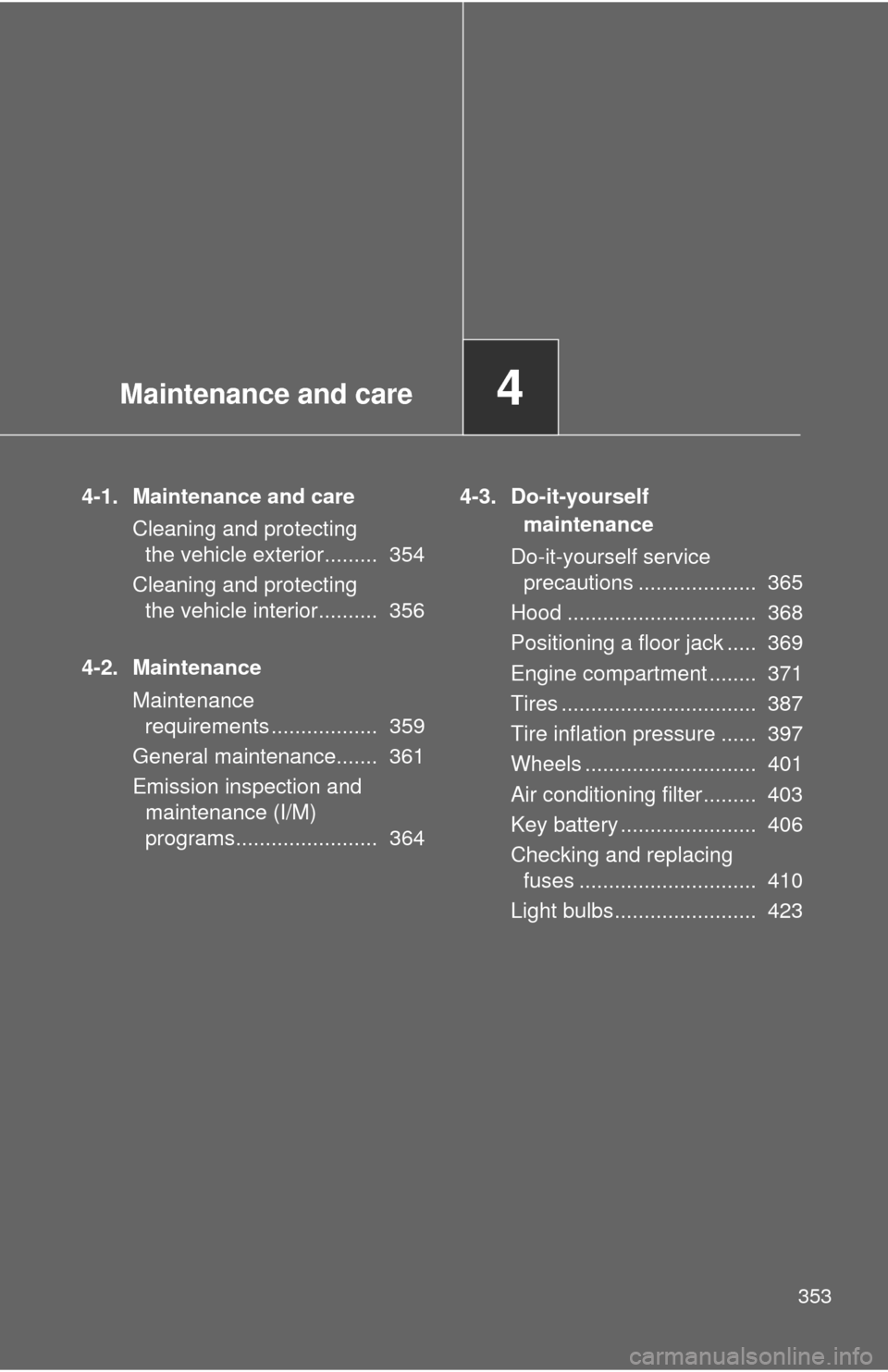
Maintenance and care4
353
4-1. Maintenance and careCleaning and protecting the vehicle exterior......... 354
Cleaning and protecting the vehicle interior.......... 356
4-2. Maintenance Maintenance requirements .................. 359
General maintenance....... 361
Emission inspection and maintenance (I/M)
programs........................ 364 4-3. Do-it-yourself
maintenance
Do-it-yourself service precautions .................... 365
Hood ................................ 368
Positioning a floor jack ..... 369
Engine compartment ........ 371
Tires ................................. 387
Tire inflation pressure ...... 397
Wheels ............................. 401
Air conditioning filter......... 403
Key battery ....................... 406
Checking and replacing fuses .............................. 410
Light bulbs........................ 423
Page 364 of 554
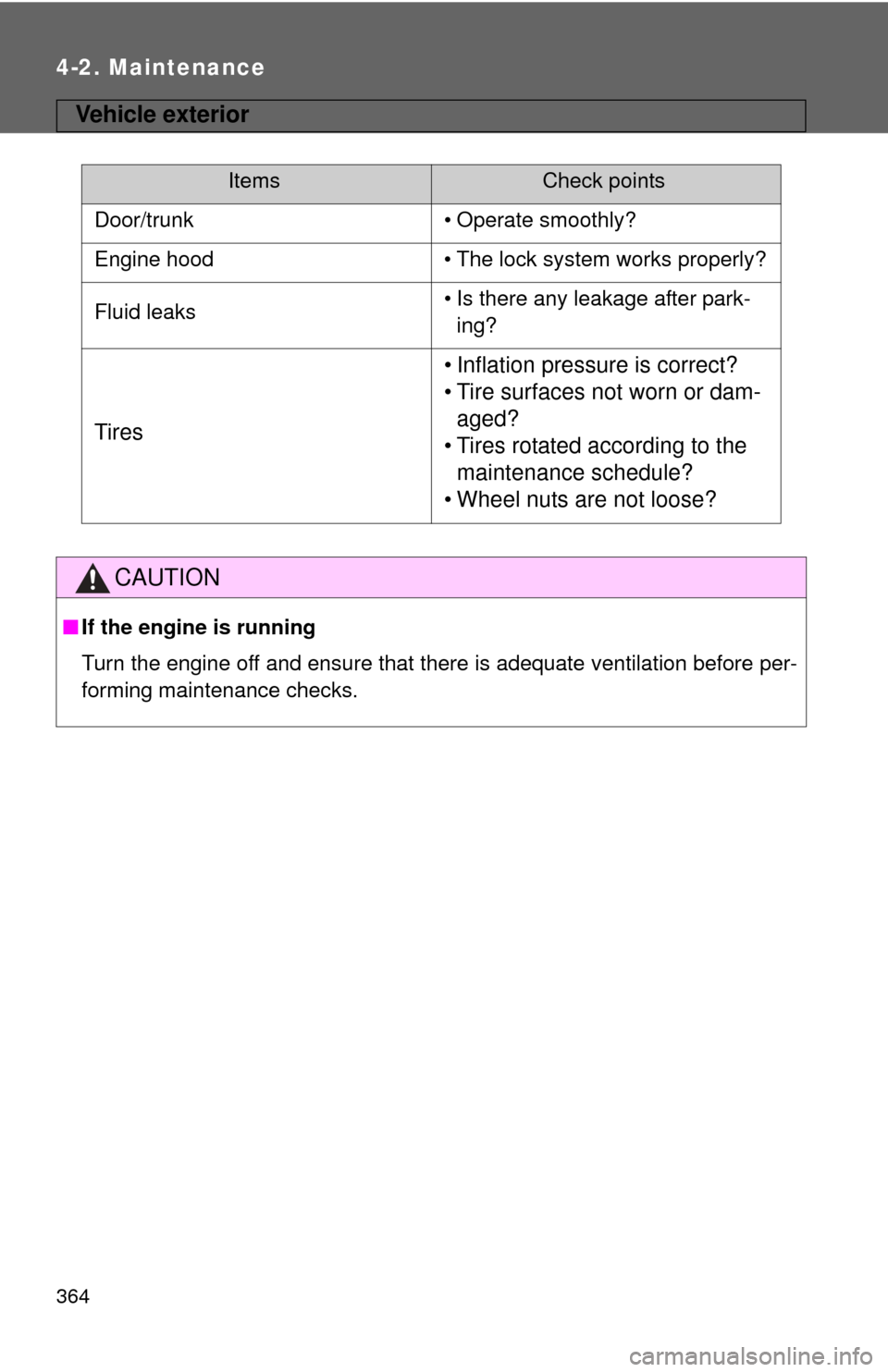
364
4-2. Maintenance
Vehicle exterior
ItemsCheck points
Door/trunk • Operate smoothly?
Engine hood • The lock system works properly?
Fluid leaks • Is there any leakage after park-
ing?
Tires • Inflation pressure is correct?
• Tire surfaces not worn or dam-
aged?
• Tires rotated according to the maintenance schedule?
• Wheel nuts are not loose?
CAUTION
■ If the engine is running
Turn the engine off and ensure that there is adequate ventilation before per-
forming maintenance checks.
Page 367 of 554
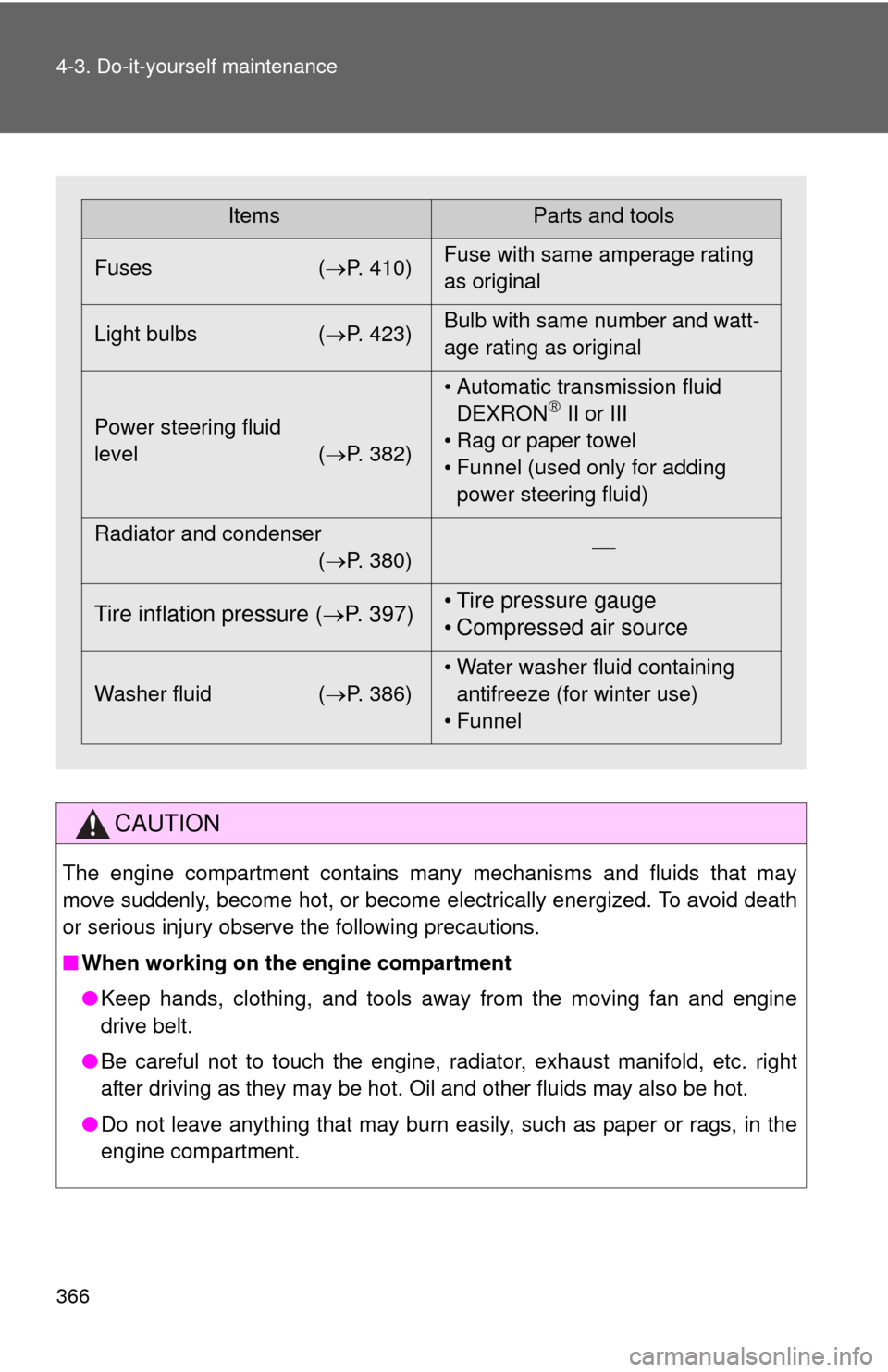
366 4-3. Do-it-yourself maintenance
CAUTION
The engine compartment contains many mechanisms and fluids that may
move suddenly, become hot, or become electrically energized. To avoid death
or serious injury observe the following precautions.
■When working on the engine compartment
●Keep hands, clothing, and tools away from the moving fan and engine
drive belt.
● Be careful not to touch the engine, radiator, exhaust manifold, etc. right
after driving as they may be hot. Oil and other fluids may also be hot.
● Do not leave anything that may burn easily, such as paper or rags, in the
engine compartment.
ItemsParts and tools
Fuses ( P. 410)Fuse with same amperage rating
as original
Light bulbs ( P. 423)Bulb with same number and watt-
age rating as original
Power steering fluid
level ( P. 382)• Automatic transmission fluid
DEXRON
II or III
• Rag or paper towel
• Funnel (used only for adding power steering fluid)
Radiator and condenser (P. 380)
Tire inflation pressure (
P. 397) • Tire pressure gauge
• Compressed air source
Washer fluid
(P. 386) • Water washer fluid containing
antifreeze (for winter use)
• Funnel
Page 388 of 554
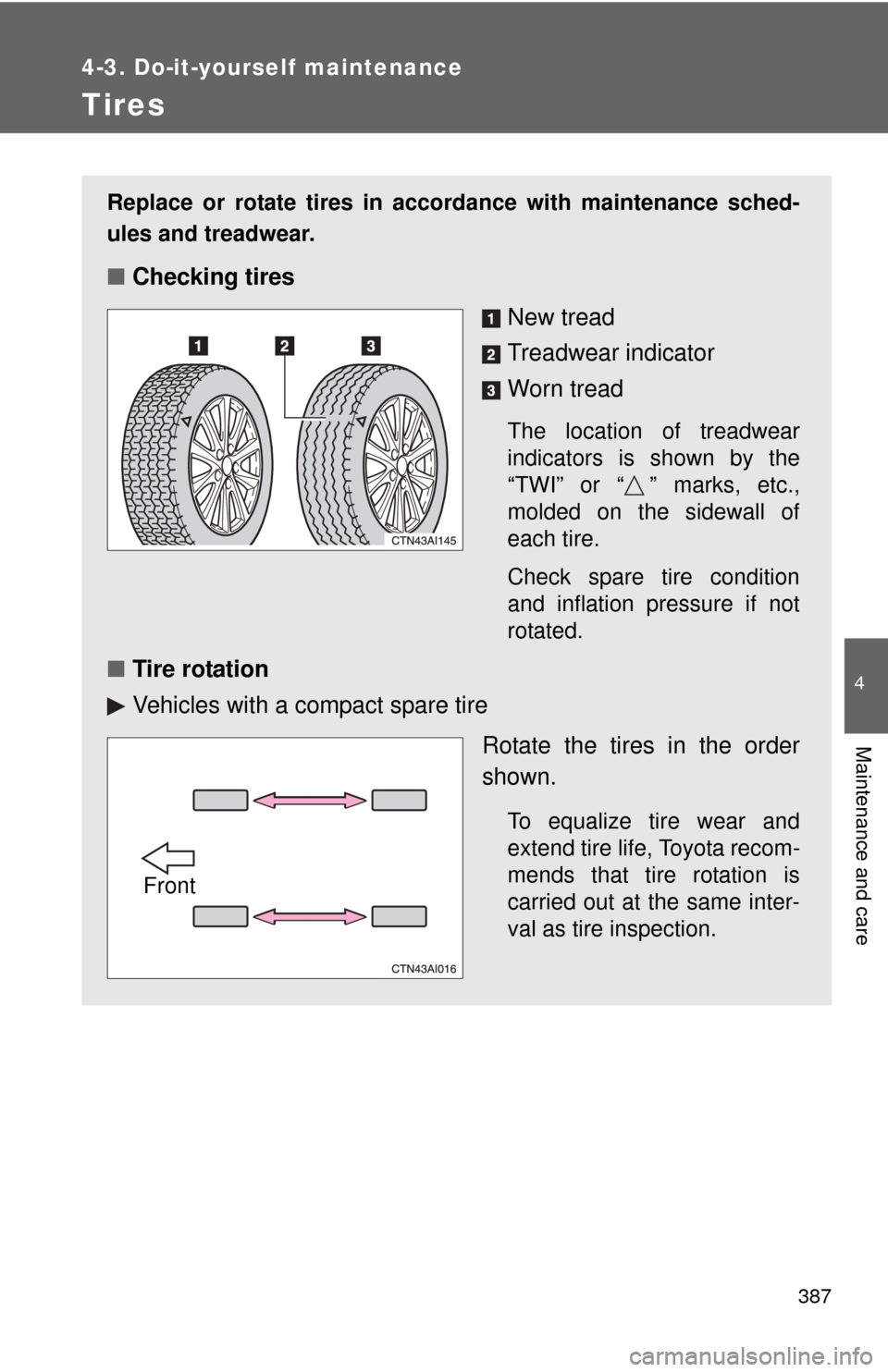
387
4-3. Do-it-yourself maintenance
4
Maintenance and care
Tires
Replace or rotate tires in accordance with maintenance sched-
ules and treadwear.
■Checking tires
New tread
Treadwear indicator
Worn tread
The location of treadwear
indicators is shown by the
“TWI” or “ ” marks, etc.,
molded on the sidewall of
each tire.
Check spare tire condition
and inflation pressure if not
rotated.
■Tire rotation
Vehicles with a compact spare tire
Rotate the tires in the order
shown.
To equalize tire wear and
extend tire life, Toyota recom-
mends that tire rotation is
carried out at the same inter-
val as tire inspection.
Front